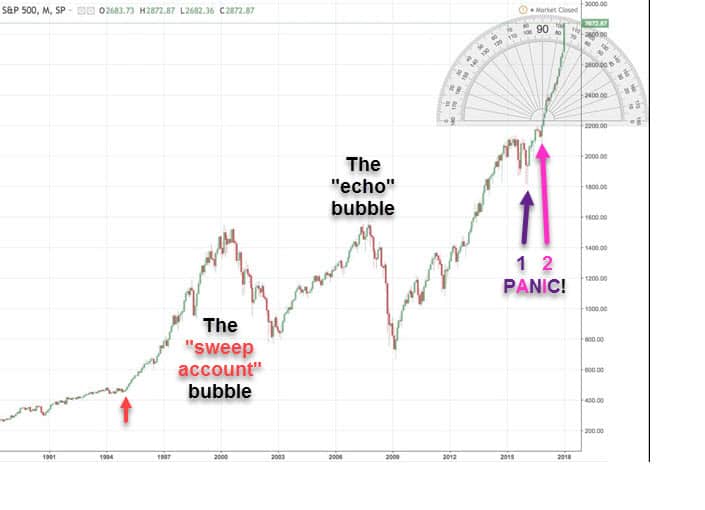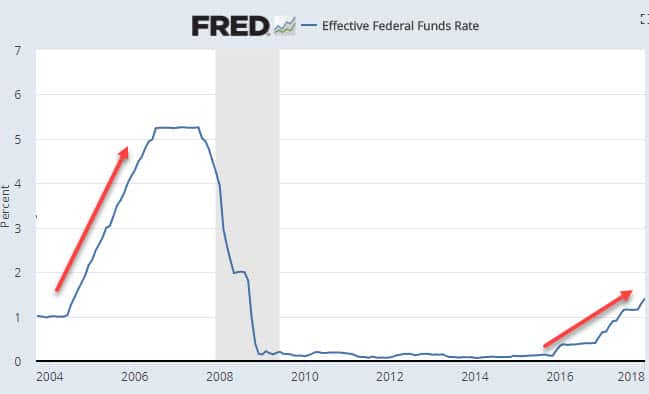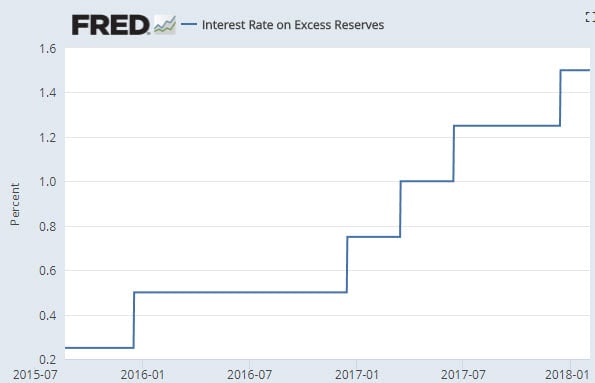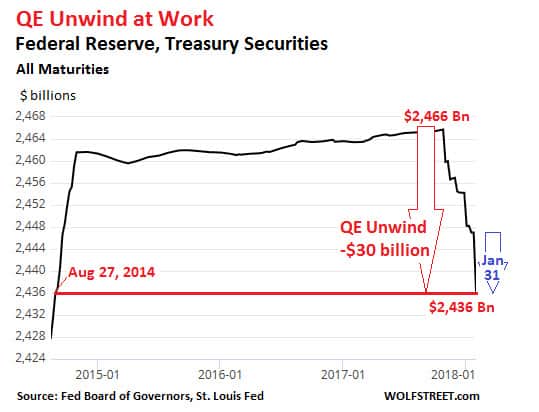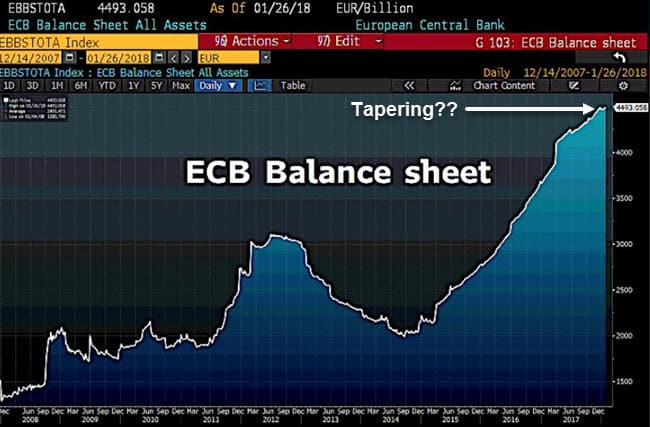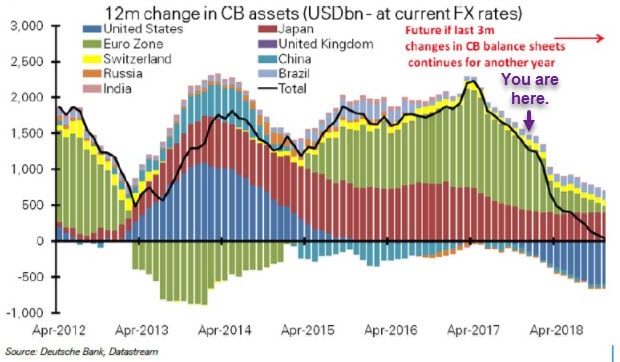Economic and market conditions are eerily like they were in late 2007/early 2008.
Remember back then? Everything was going great.
Home prices were soaring. Jobs were plentiful.
The great cultural marketing machine was busy proclaiming that a new era of permanent prosperity had dawned, thanks to the steady leadership of Alan Greenspan and later Ben Bernanke.
And only a small cadre of cranks, like me, was singing a different tune; warning instead that a painful reckoning in our financial system was approaching fast.
It's fitting that I'm writing this on Groundhog Day, as to these veteran eyes, it sure has been looking a lot like late 2007/early 2008 lately...
The Fed's 'Reign Of Error'
Of course, the Great Financial Crisis arrived in late 2008, proving that the public's faith in central bankers had been badly misplaced.
In reality, all Ben Bernanke did was to drop interest rates to 1%. This provided an unprecedented incentive for investors and institutions to borrow, igniting a massive housing bubble as well as outsized equity and bond gains.
It's worth taking a moment to understand the mechanism the Federal Reserve used back then to lower interest rates (it’s different today). It did so by flooding the banking system with enough “liquidity” (i.e. electronically printed digital currency units) until all the banks felt comfortable lending or borrowing from each other at an average rate of 1%.
The knock-on effect of flooding the US banking system (and, really, the entire world) in this way created an echo bubble to replace the one created earlier during Alan Greenspan’s tenure (known as the Dot-Com Bubble, though 'Sweep Account' Bubble is more accurate in my opinion):
The above chart shows the Fed’s 'reign of error'. It began with the deeply unfortunate sweeps program initiated at the end of 1994 (described below), proceeded to the echo bubble that itself broke in 2008 with even greater damage done, and all of which has led us to where we are today.
Note the twin panics of 2016 on the above chart. Panic #1 occurred when our current bubble threatened to burst -- that scared the living daylights out of the Big 3 central banks: the Fed, the ECB and the BoJ. So they colluded to juice the markets and boy, did they succeed. Panic #2 was the surprise election of Donald Trump. So much thin-air currency was created and dumped into the markets after that unpredicted event that we got that the markets have pretty much gone vertical ever since (note the protractor in the chart above).
When this current bubble pops, the one that I've repeatedly described as The Mother Of All Financial Bubbles, the ensuing damage will be many multiples of that caused by the bursting of the bubbles that preceded it. That’s the nature of these things: you either take your lumps when you should, or you pay a far steeper price later on.
So far, we've done all we can to postpone any consequences as far into the future as possible. Someday, maybe someday very soon, those consequences will arrive. And, at our unprecedented extremes in (over)valuation, the price we will have to pay then will be very steep indeed.
Swept Away
One of Greenspan's biggest sins while at the helm of the Federal Reserve was allowing the banks to implement “sweep accounts” for retail deposit accounts.
Banks are required to hold some of your deposited money ‘”in reserve”, commonly around 10%, to act as a cushion against insolvency risk. This means that if you have $1,000 on deposit at a bank, it's supposed to have $100 of that in cash on hand in case you unexpectedly walk in and demand some of your money back.
Since it’s only during a bank run that everybody wants 100% of their money back, the Federal Reserve only required banks to keep just 10% of depositor money on hand at any given time. They rest can be loaned out. (That's why this is called 'fractional reserve lending').
Banks don’t make very much money by holding onto your money. They want to “put it to work". Through the miracle of fractional reserve banking (at 10% in reserve) your deposited $1,000 can be turned into $9,000 of new loans.
Instead of offering you 0.5% on your savings while getting 1.5% on a Treasury bond (booooooring!) and pocketing the 1% spread, banks would prefer to lend out 90% of your deposit to a homeowner while charging 4% and pocketing a whopping 3.5% spread.
In Scenario A the banks make $10 from their 1% spread on $1,000. In Scenario B they make $355 in net interest profits on your same $1,000 deposit. That's a big difference.
But what if even that’s not enough to sate the banks' hunger for greater profit? What if the banks feel overly hamstrung by that pesky 10% reserve requirement? What if they only had to hold 5% in reserve?
Well, then $20,000 in loans can be made against your $1,000 deposit. If we call this Scenario C (again at a 4% loan rate,) then banks can make $755 in net interest profit on the back of your $1,000 deposit. Now that’s more exciting!
But how to get around that pesky 10% reserve requirement? This is where Alan Greenspan stepped in back in 1994. Facing unwanted tightness in the corporate bond market, an effort was made to inject more liquidity into the system. Greenspan's solution for where that new money should come from was to allow the extension of sweep accounts into retail banking.
Now, what's a sweep account? Good question.
If you have a checking account with a bank, you very likely also have a corresponding sweep account (also in your name) that you probably never knew was there.
Each night, right before the bank's reserve snapshot is taken, all of the money in your checking account is briefly "swept" into a special sweep account which has no reserve requirements. So, when the reserve snapshot is taken for your bank, presto!, there's no money in your checking account -- so, as far the regulators are concerned, your bank need not hold any money in reserve for that account.
And right after the reserve snapshot is taken, presto again!, your money is swept right back into your checking account.
Sounds crazy or, at least, illegal -- right? But it's real.
From the Federal Reserve itself we get this description of sweep accounts:
Since January 1994, hundreds of banks and other depository financial institutions have implemented automated computer programs that reduce their required reserves by analyzing customers' use of checkable deposits (demand deposits, ATS, NOW, and other checkable deposits) and "sweeping" such deposits into savings deposits (specifically, MMDA, or money market deposit accounts). Under the Federal Reserve's Regulation D, MMDA accounts are personal saving deposits and, hence, have a zero statutory reserve requirement.
(Source)
The result of this program effectively removed reserve requirements altogether, allowing a flood of new lending to proceed. Sure, that fixed the corporate bond market tightness; but it also gave rise to the massive stock bubble of the late 1990s (see the red arrow pointing upwards on the above chart).
So why focus so much on the creation of the sweep accounts program?
First: this was the original error that the Fed has been responding to ever since, just as a drunk driver responds to a skid by oversteering this way then that way with the skid, over-correcting too much each time. If you want to understand today’s dilemmas you have to know this little bit of history.
Second: this was the beginning of the “We’ll just change the rules when it suits our needs” regime that has now so utterly infected the regulatory apparatus of the US financial system. As a result, for all practical purposes, there really aren’t any iron-clad rules we can count on anymore.
The corollary to this is that creating a lot of easy money is fun and exciting for a while, but then make things far worse in the end.
Why is that? Because you can't print prosperity. Money printing only steals prosperity from the masses, and most especially, from future generations -- that’s all the central banks really ever can do.
But theft isn't a sustainable form of governance. The central banks reign of error(s) will continue and compound until we, the people, finally rise up and demand something different.
What will it take to create enough public outrage to trigger this? Well, how about another massive financial crisis, one that may make 2008 look tame in comparison?
Look, bubbles always burst. And there are very worrying signs that the current Mother Of All Financial Bubbles is ending right now.
What most has my attention are spiking interest rates and oil prices threatening to head above $70/bbl. These are twin shocks that our extremely over-indebted and over-leveraged economic system simply can't withstand for long before breaking down.
It’s 2007/2008 All Over Again
The warning signs in 2007 were abundant and, for most, completely obvious in hindsight. I was writing about them extensively at the time and, today, I see too many parallel features for comfort. It's not that conditions are exactly the same, but they're so similar that we’d have to quibble to separate them.
Whereas in 2007 people were borrowing heavily against their rising home prices, today we have record household debt, record auto loan balances (in terms of both payment schedule length and amount), record corporate debt, and record sovereign debts.
In 2007 the Fed was carefully raising rates to see if they could build up an interest rate buffer. Today, we also have rising rates and declining market liquidity due to reduced central bank QE activity:
(Source)
Note that "raising rates” today isn't exactly the same as it was in 2007, save that that borrowing money costs you a little more. So, yes, auto loans and mortgages all cost a little more than they did a few months ago.
But unlike the mechanism the Fed used in 2007, today it's not driving interest rates higher by withdrawing liquidity. Instead, it's doing so by simply offering a higher rate of interest to banks on their excess reserves (IOER), and that drags the overall rate of interest up.
Why? Because if you're a bank and you have the choice between either lending overnight to another bank or lending money to the Fed (which is completely risk-free), then you're going to take the best deal. Right now, the Fed is offering pretty sweet terms.
This chart explains why and how the Fed has been able to raise rates without draining liquidity:
Without this little feature, unwisely authorized by congress in 2008, the Fed would have to drain many hundreds of billions of dollars from the system to hike interest rates. Instead, now they can just set the IOER higher, as if it were a magic dial that sets the price of money.
It’s a cool trick. But it's newness prevents us from looking to past interest hiking cycles for clues as to how this current one will play out. The dynamics are totally different.
Now, the Fed is starting to drain liquidity from the system, too. It's using a process it refers to as ‘reducing its balance sheet.’
On that front, we see that the Fed has allowed some $30 billion of Treasurys to ‘roll off’ its balance sheet. This simply means that when these instruments matured, the Treasury Department returned the principal to the Fed (thus 'retiring' the bonds), instead of seeing the Fed replace the bonds by printing up more money to buy more of the same securities at the next Treasury auction:
(Source)
While the above chart may look dramatic, it’s not really. It won't really impact things much as long as the ECB and the BoJ continue to print and dump more new digital currency into world markets. (Although, they've publicly committed to tapering these purchases in the future -- so far that’s not really in the data unless we squint hopefully at the last little wiggle in the chart below):
But what really matters is this next chart, which shows the combined stimulus across all the major central banks. Since the financial system is truly global now, it matters less what any one central bank is doing and instead we have to look across them all.
When we do, this is what we see:
(Source)
Anything above the zero line means that central banks are still dumping money into the system. So they are not collectively ‘tightening’ yet, which would technically mean they would be removing money from the system -- as they are slated to do somewhere around the beginning of 2019.
However, the world’s debt levels and stock and bond prices are all so massively stretched and elevated, that simply even doing less money printing may have the same effect as tightening. Believe it or not, we’re coming off of the largest year of money printing in all of history in 2017.
Think about that for a second…nine years into the ‘recovery’ and the central banks printed the largest amount of emergency money ever.
Which is it? Are we still experiencing an emergency of historically unprecedented magnitude? Or are we years into enjoying a robust "recovery", as our media and elected officials have been telling us?
Of course, we've been writing here at PeakProsperity.com for years that our global economic and financial systems are dramatically more tenuous than we're being told
In my calculation, the markets cannot withstand any reduction in stimulus. If the projected tightening actually occurs, asset prices will begin to fall violently in response. When that occurs, all the central banks' promised plans will be tossed in the trash can. The ensuing rescue efforts will unleash a tidal wave of liquidity that will dwarf the efforts of the past decade, and very likely destroy the remaining purchasing power of the world's major fiat currencies.
But first, the markets will need to fall hard, in order to give the central bankers enough political air cover for such drastic action. Expect to see days where the Dow closes down between 500 - 1,000 points in a single day.
Just like today...
Assume The Crash Position
So, is the top in? Are the markets in the process of rolling over?
In Part 2: Is This It? we examine the congregating perfect storm of crash triggers -- rising interest rates, a fast-weakening dollar, a sudden return of volatility to the markets after a decade of absence, rising oil prices -- and calculate whether today's 666-point drop in the Dow is the start of a 2008-style market melt-down (or worse).
Make no mistake: these are sick, distorted, deformed and liquidity-addicted markets. They've gotten entirely too dependent on continued largess from the central banks.
That is now ending.
After so many years of such extreme market manipulation finally gives way, the coming losses will be staggeringly enormous.
The chief concern of any prudent investor right now should be: How do I avoid being collateral damage in the coming reckoning?
Click here to read Part 2 of this report (free executive summary, enrollment required for full access)
This is a companion discussion topic for the original entry at https://peakprosperity.com/its-looking-a-lot-like-2008-now/
